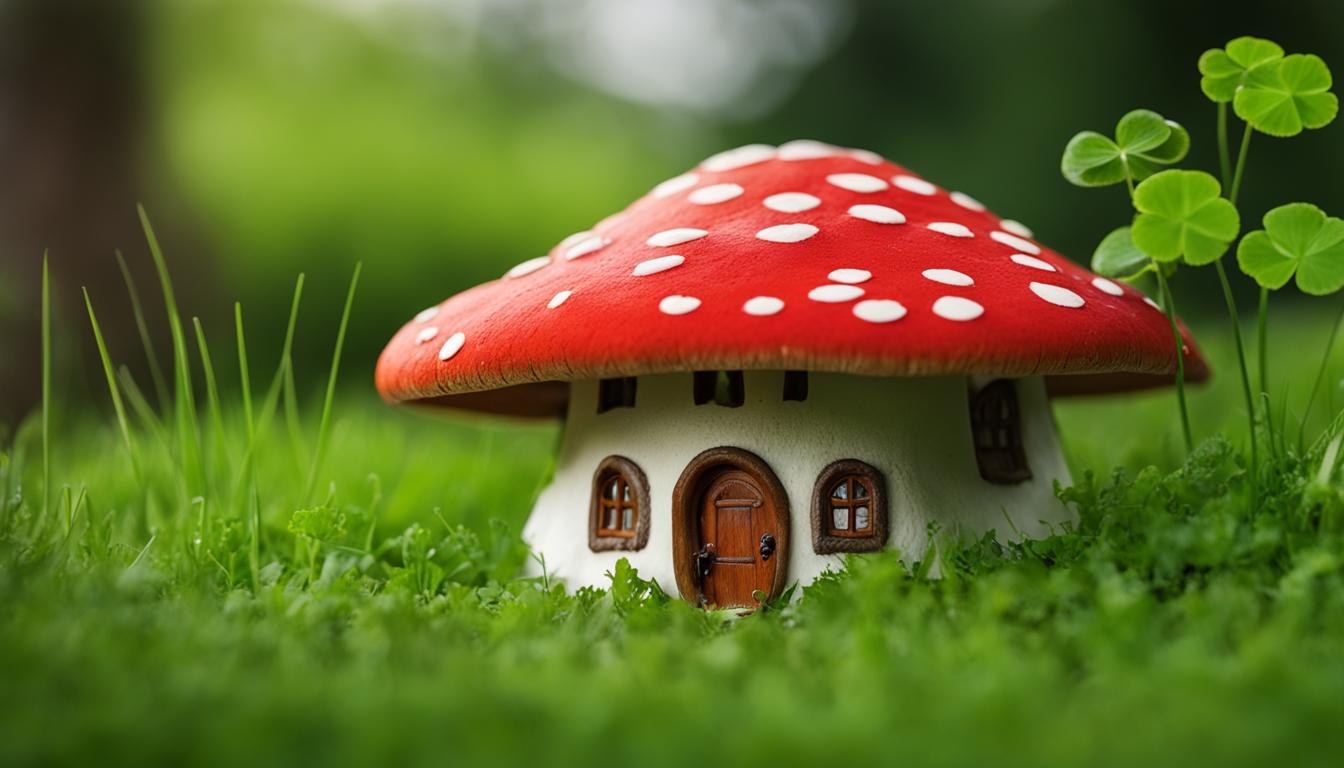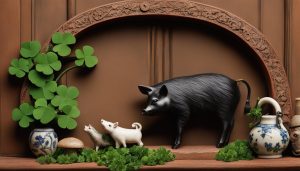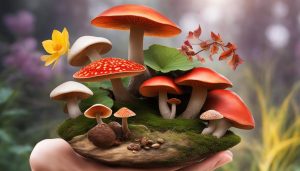In German tradition, the mushroom is considered a symbol of good luck. The red and white speckled Amanita muscaria mushroom, also known as the lucky mushroom or Glückspilz in German, holds cultural significance and is associated with various customs and beliefs. This tradition combines folklore and Christmas, as these mushrooms grow at the base of Christmas trees in the wild and are believed to be a favorite food of reindeer. The Germans would traditionally decorate their Christmas trees with dried mushrooms, although this practice is no longer recommended due to the toxic nature of these mushrooms. Instead, cute and safer versions of the lucky mushroom ornament are now used for holiday decorations.
Contents
- 1 The Symbolic Meaning of the Lucky Mushroom in German Culture
- 2 The Historical Origins of German Mushroom Folklore
- 3 German Mushroom Traditions in Modern Times
- 4 Mushrooms as Symbols of Good Luck Worldwide
- 5 German Tradition and Mushroom Decorations
- 6 Exploring the Charming Tradition of the Lucky Mushroom in Germany
- 7 FAQ
- 7.1 What is the significance of the lucky mushroom in German culture?
- 7.2 Why are mushrooms associated with Christmas traditions in Germany?
- 7.3 Where did the tradition of using lucky mushrooms in German culture come from?
- 7.4 Are the traditional lucky mushrooms in Germany safe for decorations?
- 7.5 How are lucky mushrooms incorporated into German Christmas traditions today?
- 7.6 What is the connection between the lucky mushroom and Santa Claus in German tradition?
- 7.7 Are mushrooms considered symbols of good luck in other cultures?
- 7.8 Why are mushroom decorations popular in Germany?
- 8 Source Links
Key Takeaways:
- The mushroom is considered a symbol of good luck in German tradition.
- The red and white speckled Amanita muscaria mushroom, known as the lucky mushroom, holds cultural significance.
- German folklore combines mushrooms, Christmas, and reindeer.
- Traditional Christmas tree decorations with dried mushrooms are no longer recommended due to their toxicity.
- Cute and safe versions of the lucky mushroom ornament are now used for holiday decorations.
The Symbolic Meaning of the Lucky Mushroom in German Culture
In German culture, the lucky mushroom holds significant symbolic meaning. It is believed to be a harbinger of good fortune and prosperity. The red and white colors of the mushroom further enhance its symbolic value, particularly during the Christmas season. The belief in lucky mushrooms is deeply rooted in German superstition, where they are considered positive omens and symbols of protection. Passed down through generations, these beliefs continue to be cherished and celebrated in German culture.
The symbolism of mushrooms in German culture goes beyond mere superstition. They are also associated with nature and the connection to the earth. Mushrooms have a unique ability to grow in dark and hidden places, representing the idea that good luck can be found even in the most unexpected circumstances. In German folklore, mushrooms are often depicted as gateways to other realms, mystical creatures, or portals to magical worlds.
“The lucky mushroom is a symbol deeply embedded in German culture, representing hope, prosperity, and protection. Its rich symbolism and association with nature make it a cherished icon that continues to captivate the imagination of the German people.”
Throughout history, mushrooms have played a significant role in German traditions and rituals. From ancient pagan practices to the modern Christmas tree decorations, they have been woven into the fabric of German culture. The enduring popularity of mushroom symbolism in Germany reflects the country’s reverence for tradition and its fascination with the power of symbols to bring luck and prosperity.
| Symbolic Meaning of the Lucky Mushroom | Significance |
|---|---|
| Good fortune and prosperity | The lucky mushroom is believed to bring luck and abundance to those who possess it. |
| Protection | Mushrooms are seen as symbols of protection in German superstition, warding off negative energies and evil spirits. |
| Connection to nature | The mushrooms’ ability to thrive in hidden places symbolizes finding luck and positivity even in unexpected circumstances. |
| Mysticism and magic | In German folklore, mushrooms are associated with mystical creatures and magical realms. |
The Historical Origins of German Mushroom Folklore
In order to understand the significance of the lucky mushroom in German culture, it is important to explore its historical origins. The tradition of associating mushrooms with good luck can be traced back to ancient pagan practices in Germany.
During winter solstice celebrations, ancient pagans would adorn pine branches with dried mushrooms. These mushrooms, particularly the red and white Amanita muscaria variety, were found growing at the base of coniferous trees and became closely linked to the winter season. Over time, this practice evolved into the decoration of Christmas trees with mushrooms.
The red and white colors of the mushrooms also had an influence on the designation of green, red, and white as the traditional Christmas colors. As these customs and beliefs were passed down through generations, mushrooms became deeply embedded in German folklore and traditions, symbolizing good luck and protection.
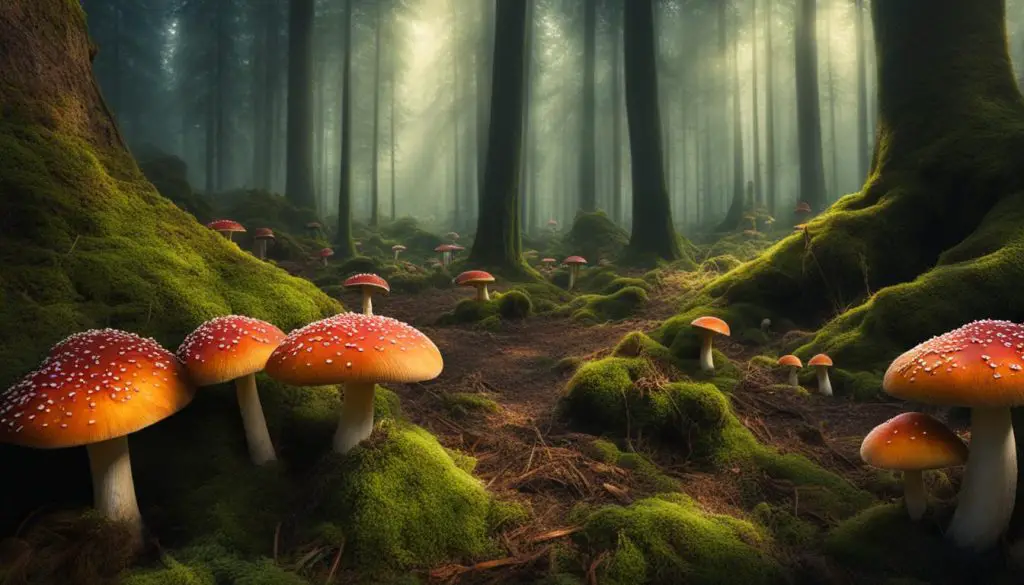
| Historical Origins of German Mushroom Folklore | |
|---|---|
| Origin | Description |
| Ancient Pagan Practices | Ancient pagans adorned pine branches with dried mushrooms during winter solstice celebrations. |
| Association with Christmas Trees | Over time, the tradition evolved into decorating Christmas trees with mushrooms. |
| Influence on Christmas Colors | The red and white colors of mushrooms influenced the designation of green, red, and white as the traditional Christmas colors. |
| Symbolism of Good Luck and Protection | Mushrooms became deeply embedded in German folklore and traditions, symbolizing good luck and protection. |
The historical origins of German mushroom folklore not only provide insights into the cultural significance of mushrooms but also highlight the country’s rich traditions and connections to nature. The practice of decorating Christmas trees with mushrooms may have evolved, but the symbolism of the lucky mushroom continues to be celebrated in modern times.
German Mushroom Traditions in Modern Times
Despite the poisonous nature of the Amanita muscaria mushrooms, which are the traditional lucky mushrooms in Germany, modern practices have shifted towards using safer alternatives for decorations. Contemporary German traditions still incorporate the symbolism of mushrooms and good luck symbols. Cute and colorful versions of the lucky mushroom ornament are now widely available, allowing people to continue the tradition of having a lucky mushroom on their Christmas trees. These ornaments can be paired with woodland-themed decorations to create a sophisticated winter forest look. German culture values the preservation of traditions, and the lucky mushroom is a cherished symbol that continues to be embraced in modern times.
While the use of toxic mushrooms as decorations is no longer recommended, Germans have found creative ways to incorporate the lucky mushroom into their festivities. These cute and safer versions of the traditional lucky mushroom ornament add a touch of charm and whimsy to holiday decorations. Whether hanging from Christmas trees or adorning tabletop displays, these ornaments symbolize the enduring belief in good luck and the desire to keep German traditions alive.
Table: German Mushroom Decorations
| Mushroom Decorations | Description |
|---|---|
| Lucky Mushroom Ornaments | Cute and colorful versions of the traditional lucky mushroom ornament are widely available. These ornaments are made from safe materials and can be hung on Christmas trees or displayed as standalone decorations. |
| Woodland-Themed Decor | German holiday decor often incorporates a woodland theme, with mushrooms, forest animals, and natural elements. These decorations create a cozy and enchanting atmosphere. |
| Mushroom Crafts | Many Germans enjoy crafting their own mushroom decorations. From felted mushrooms to painted ceramics, these handmade creations add a personal touch to holiday displays. |
The enduring popularity of mushroom decorations in Germany reflects the country’s rich cultural heritage and its fascination with symbols of good luck and nature. By embracing safer alternatives and adapting traditional practices, Germans continue to celebrate the lucky mushroom as a cherished symbol of their beliefs and traditions.
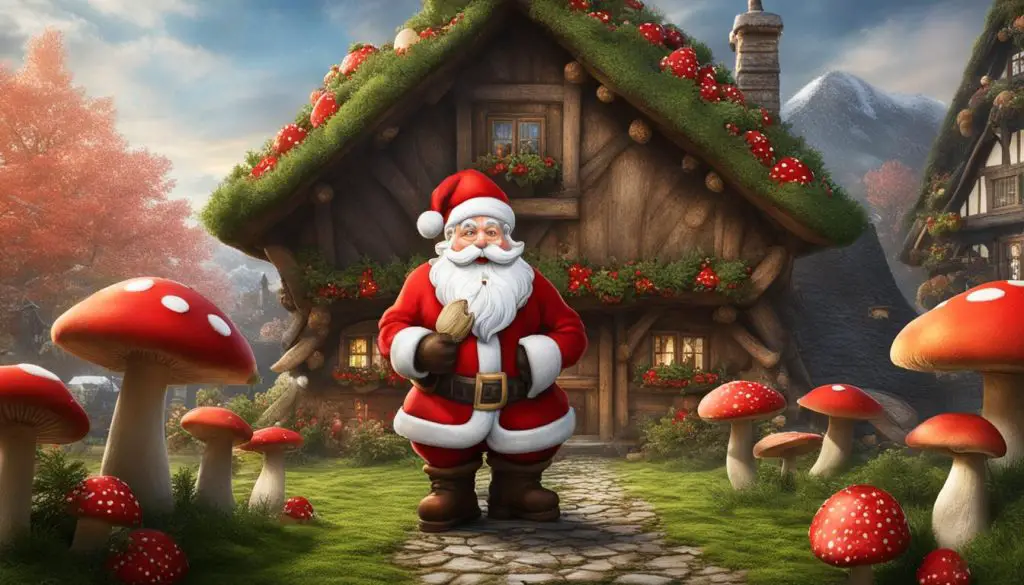
Mushrooms as Symbols of Good Luck Worldwide
The cultural significance of mushrooms extends far beyond Germany. Throughout the world, mushrooms are viewed as symbols of good luck, prosperity, and longevity. This belief can be traced back to ancient cultural traditions and folklore, highlighting the enduring fascination with these unique organisms.
In German mushroom folklore, the lucky mushroom holds a special place, symbolizing good fortune, protection, and prosperity. However, the symbolism of mushrooms as symbols of good luck extends to many other cultures as well. In Asia, mushrooms are seen as a positive symbol of longevity and are often incorporated into traditional medicine and cuisine. Native American tribes also have beliefs surrounding mushrooms, viewing them as sacred and powerful symbols of the earth’s abundance.
“Mushrooms have been celebrated for centuries in many cultures worldwide,” says Professor Angela Wagner, a folklore expert. “Their unique growth patterns, mysterious nature, and association with the earth’s fertility make them powerful symbols of luck and prosperity.”
The global significance of mushrooms as symbols of good luck adds depth to our understanding of German mushroom folklore and the cultural significance attached to these fascinating organisms. It showcases the universal human fascination with nature’s symbols and the desire to find luck and prosperity in our lives.
The Cultural Significance of Mushrooms in Germany
In Germany, the symbolism of mushrooms goes beyond their association with good luck. These unique organisms are deeply intertwined with German culture, folklore, and traditions. From their historical origins as decorations on Christmas trees to their continued presence in modern-day mushroom motifs, mushrooms hold a special place in German society.
The association between mushrooms and good luck in Germany reflects the country’s rich cultural heritage and its reverence for nature. The continued popularity of mushroom decorations during the holiday season and throughout the year demonstrates the enduring appeal of these symbols and their significance in German culture.
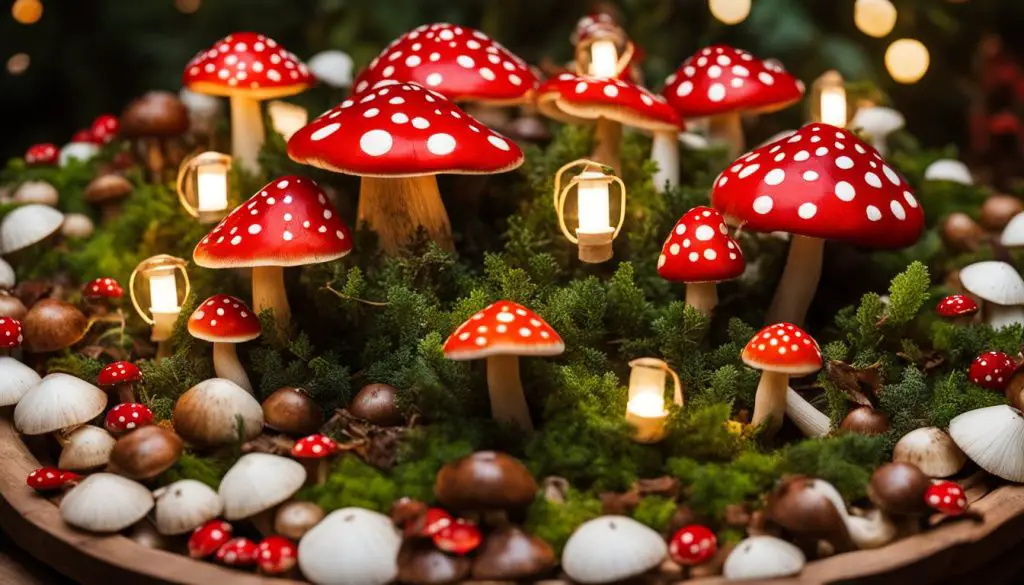
| Country | Cultural Significance |
|---|---|
| Germany | Mushrooms symbolize good luck, protection, and prosperity. |
| China | Mushrooms are associated with longevity and are used in traditional medicine and cuisine. |
| United States | Native American tribes view mushrooms as sacred symbols of abundance and the earth’s fertility. |
German Tradition and Mushroom Decorations
German tradition embraces the charm and symbolism of mushroom decorations, which have become a popular choice for holiday and year-round decor. These whimsical ornaments, often featuring the iconic red and white speckles of the Amanita muscaria mushroom, add a touch of magic and nostalgia to homes in Germany. Whether it’s Christmas time or any other season, mushroom motifs can be found on ornaments, cards, and other decorative items at German Christmas markets.
The enduring popularity of mushroom decorations in Germany is a testament to the country’s rich cultural heritage and its fascination with symbols of good luck and nature. While the traditional use of toxic mushrooms is no longer recommended, modern versions of the lucky mushroom ornament are widely available, ensuring that the tradition lives on in a safe and enjoyable way. These adorable ornaments can be paired with other woodland-themed decorations to create a sophisticated winter forest look.
Table: The Significance of Mushroom Decorations in German Culture
| Symbolism | Cultural Significance |
|---|---|
| Mushrooms as good luck symbols | Reflects German belief in the positive energy and protection brought by lucky mushrooms. |
| Mushrooms as symbols of prosperity | Associated with wealth, abundance, and a bountiful harvest. |
| Mushrooms as a connection to nature | Highlights Germany’s reverence for the natural world and its role in cultural traditions. |
Beyond the holiday season, mushrooms continue to be embraced as symbols of good luck in various aspects of German culture. From crafts and designs to home decor, the enduring popularity of mushroom decorations showcases the importance of these symbols in German traditions. By incorporating mushroom motifs into their homes, Germans celebrate their cultural heritage and embrace the whimsy and magic that these charming ornaments bring.
Exploring the Charming Tradition of the Lucky Mushroom in Germany
The lucky mushroom holds a special place in German culture and traditions. With its deep-seated symbolism of good luck, protection, and prosperity, the red and white speckled Amanita muscaria mushroom has become an iconic symbol associated with German folklore.
The history of mushroom traditions in Germany traces back to ancient pagan practices, which evolved into the decoration of Christmas trees with dried mushrooms. Today, while the use of the toxic mushrooms is no longer recommended, cute and safe versions of the lucky mushroom ornament continue to be cherished and displayed during the holiday season.
The enduring popularity of mushroom decorations in Germany reflects the country’s rich cultural heritage and its fascination with symbols of good luck and nature. German belief in lucky mushrooms is deeply ingrained in superstition, with the mushroom being seen as a positive omen and a symbol of protection. This cherished tradition continues to bring joy and whimsy to German homes, reminding us of the power of symbols in shaping our cultural identity.
FAQ
What is the significance of the lucky mushroom in German culture?
The lucky mushroom is believed to bring good fortune and prosperity in German culture. It is deeply rooted in German superstition and seen as a positive omen and a symbol of protection.
Why are mushrooms associated with Christmas traditions in Germany?
Mushrooms are associated with Christmas traditions in Germany because they grow at the base of Christmas trees in the wild and are believed to be a favorite food of reindeer. The Germans used to decorate their Christmas trees with dried mushrooms, although this practice is no longer recommended due to the toxic nature of these mushrooms.
Where did the tradition of using lucky mushrooms in German culture come from?
The tradition of using lucky mushrooms in German culture can be traced back to ancient pagan celebrations during the winter solstice. The Amanita muscaria mushrooms were found growing at the base of coniferous trees, and ancient pagans would use the dried mushrooms to adorn pine branches. Over time, this practice evolved into the decoration of Christmas trees with mushrooms.
Are the traditional lucky mushrooms in Germany safe for decorations?
No, the traditional lucky mushrooms in Germany, the Amanita muscaria mushrooms, are toxic. It is no longer recommended to use these mushrooms for decorations. Instead, safer versions of lucky mushroom ornaments are now used for holiday decorations.
How are lucky mushrooms incorporated into German Christmas traditions today?
Cute and colorful versions of lucky mushroom ornaments are now widely available for German Christmas decorations. They can be paired with woodland-themed decorations to create a sophisticated winter forest look.
What is the connection between the lucky mushroom and Santa Claus in German tradition?
Santa Claus’s red and white costume is said to be inspired by the Amanita muscaria mushrooms, with their red and white colors. Additionally, folklore suggests that reindeer would consume these mushrooms and prance around in an intoxicated manner, which could have influenced the association between reindeer and Santa’s sleigh.
Are mushrooms considered symbols of good luck in other cultures?
Yes, mushrooms are considered symbols of good luck in many parts of the world, including Asia and North America. They are often associated with prosperity, longevity, and luck in various cultural traditions and folklore.
Why are mushroom decorations popular in Germany?
Mushroom decorations are popular in Germany because they add a touch of magic and whimsy to home decor. The unique charm of the lucky mushroom, with its red and white appearance, appeals to people’s sense of enchantment.

